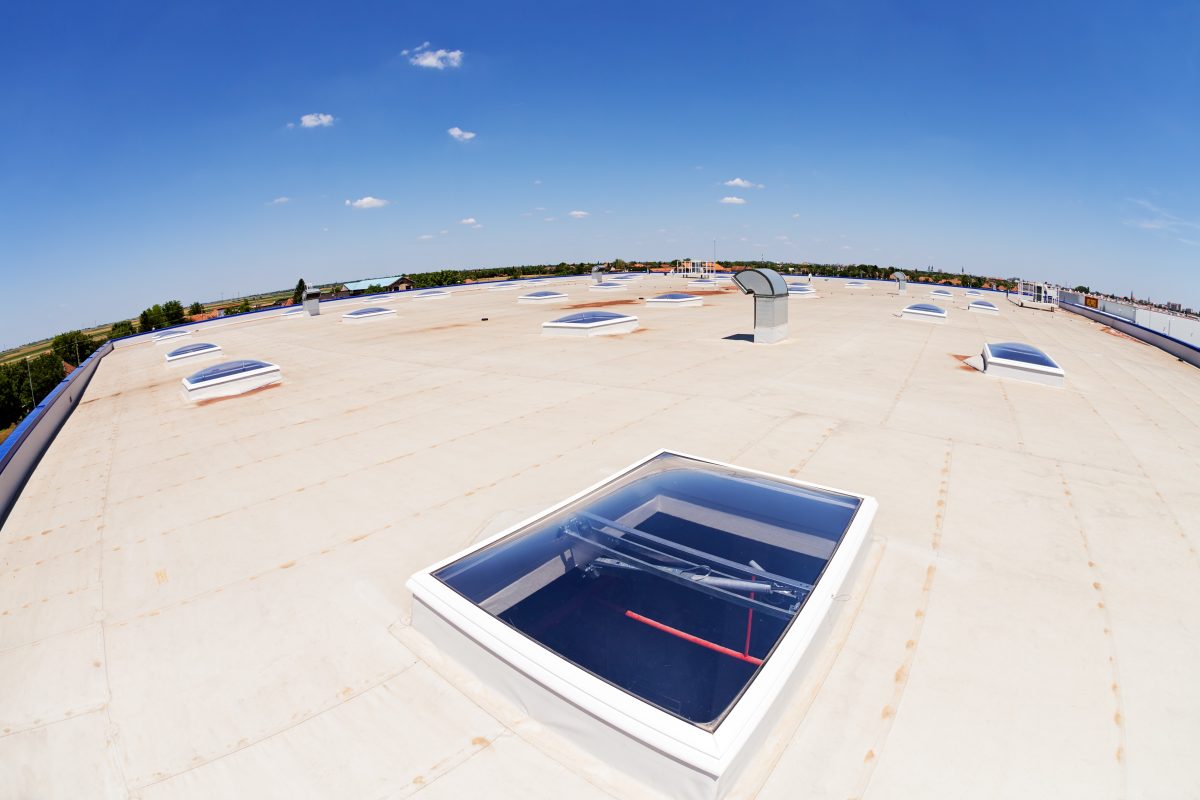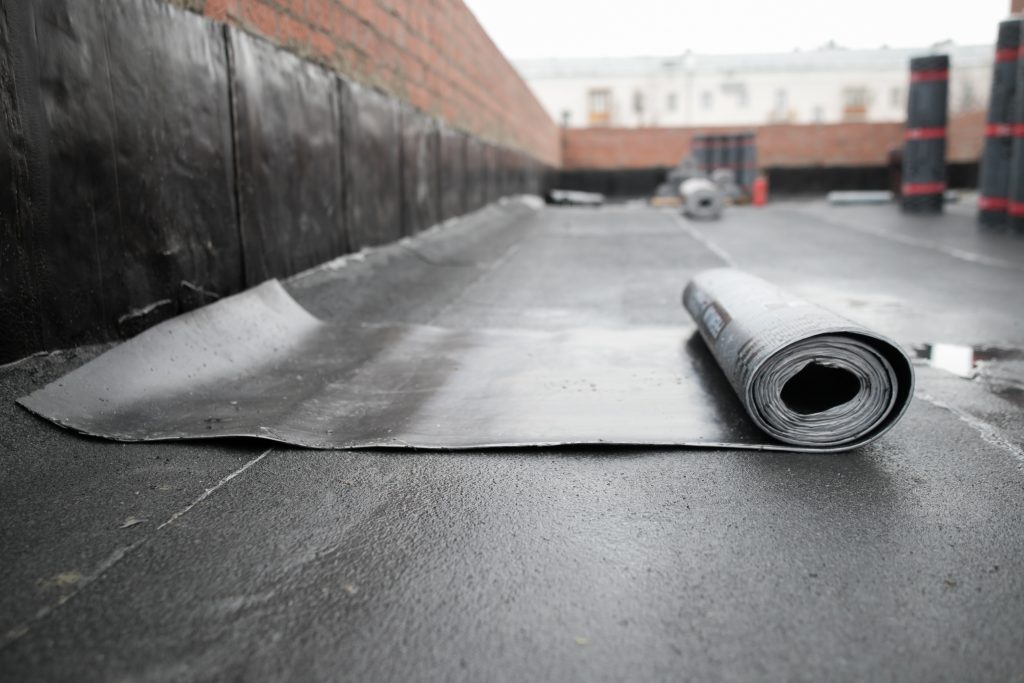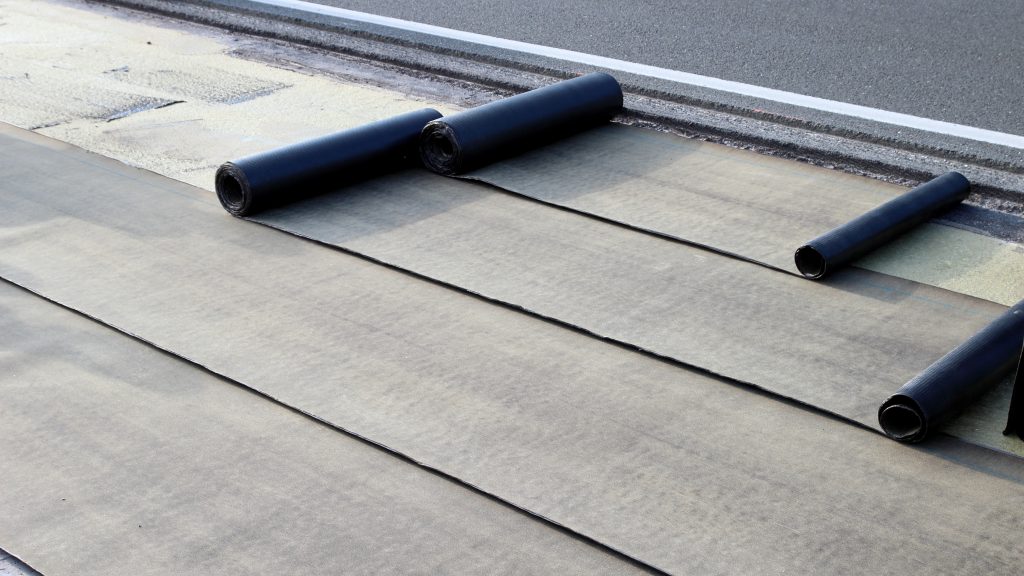
24 Oct Pros and Cons of Flat Roofing
While using flat roofing might not be the most stylish option, it holds significant advantages. Flat roofs are an aesthetically exciting and energy-efficient alternative to traditional sloped roofs. Although flat roofs pose several issues in comparison to sloped roofs, many homeowners favour flat roofs for several reasons.
Flat roofs are typically versatile, and easier to maintain than most sloped roofs, making homeowners enjoy the lower maintenance cost of long-term ownership. However, despite their advantages, it’s vital to consider the drawbacks of flat roofs. Notably, a flat roof can turn into a significant disaster without the right contractor and planning.
Flat roofs are among the most controversial roofs of all the types of roofs for buildings and homes. They are commonly used on outbuildings and large structures.
Furthermore, a flat roof is the option most homeowners opt for among the various kinds of roofs in the market.
However, before you choose to have one, it’s necessary for you to understand its unique pros and cons. Why should you choose a flat roof? The drawbacks of using flat roofing, and in such a scenario – how can you prevent damages?
In this article, we will explain the pros and cons of flat roofing, flat roofing in Canada today and what to know about flat roofing.

What is Flat Roofing?
Flat roofing, just as the name implies, is a type of roof laid horizontally with little or no inclination. Although the name suggests a horizontal surface, a slight angle must be included to allow for the drainage of rainwater.
Generally, flat roofs consist of the topcoat, which can be made from several different materials, and an underlayment.
Flat roofs can be extremely beneficial if you are extending or building from scratch. However, it is essential to have the right knowledge of flat roofs before you make a commitment to using one.
Related article: Flat Roof Repair – How to Repair a Leaky Flat Roof
Types of Flat roofing
Roofs take abuse and require maintenance. Make no mistake about that. Sloping or pitched roofs help shed water and minimize snow build up. As a result, sloped roof systems like asphalt shingles, tiled roofs, or wood shake roofs are designed like fish scales, overlapping pieces designed to shed water.
Flat roofing is a different animal. With shallow slopes (between 1/4” to 1/2” per foot if appropriately constructed), flat roofs do not readily shed water. These flat roofs are designed as a monolithic roof surface and need to be able to handle some limited time of standing water.
There are three main types of flat roof systems:
- Membrane or ‘Single-Ply’ Roofing – such as EPDM.
- Built-Up Roofing (BUR).
- Modified Bitumen Roofing.
EPDM is the newest flat roof technology (+/- 55 years), and BUR is the oldest (+/- 120 years). Modified Bitumen is in between (+/- 60 years). In this article, we will review the pros and cons of each flat roofing material. Keep reading to make the best choice for your next building.
Pros and Cons of EPDM Single-Ply Membrane Roofing
There are different types of rubber/polymer membrane roofs, including PVC, Neoprene, EPDM and a few others. However, EPDM – Ethylene Propylene Diene Monomer is the most commonly used, especially for residential applications in Toronto.
EPDM flat roofing is made of recycled rubber materials, which makes it environmentally friendly. It also helps to insulate your roof and attic ― and cuts down on cooling and heating costs ― which makes it economically friendly as well. EPDM roofing shingles come in a wide variety of textures and colours.
Pros of EPDM Single-Ply Membrane Roofing
- EPDM roofing is waterproof.
- It allows you to encase your entire roof.
- Repairs are relatively inexpensive and straightforward. As a homeowner, you can even take on DIY repairs.
- Roofs last between 30 and 50 years and hold up against the wind, water, and fire.
- The roof deck doesn’t need reinforcement because EPDM roofing is lightweight.
- Leaks are sporadic with EPDM roofing.
- EPDM roofing is durable. It doesn’t scratch or scuffs very quickly and repairs are easy.
Cons of EPDM Single-Ply Membrane Roofing
- You must have an EPDM roof installed by a professional contractor who knows how to install the roof correctly. This installation can be somewhat costly.
- Any exterior pieces – pipes, HVAC systems, chimneys – can pose a risk to your EPDM roofing and cause leaks if not properly flashed.
- Rubber roofing can be damaged by branches, foot traffic during installation, or storm damage. You need to take more care when walking on a membrane roof.

Pros and Cons of Built-Up Roofing (BUR)
Built-up roofing (BUR) was the most common type of flat roof type until single-ply roofing, and modified Bitumen was invented. BUR uses tar and gravel to create a watertight layer over the roof. Some of the main benefits of built-up roofing include its longevity, its full coverage of the roof deck, and its high resistance to damage.
It’s an expensive roofing choice for a residential home, and some of the odours that come with tar and gravel can be disconcerting. Here are some additional pros and cons of built-up roofing:
Pros of Built-Up Roofing (BUR)
- Built-up roofing can last for 10 to 15 years with regular maintenance and repair.
- Several types of built-up roofing exist to meet your needs―smooth asphalt built-up, ballasted asphalt built-up, cold built-up, etc.
- It offers excellent protection against water, UV rays, and inclement weather.
- It is low maintenance and costs very little to maintain throughout its lifetime.
- It’s easy to remove layers when repairing or resurfacing the roof.
- The gravel in built-up roofing makes it highly resistant to regular foot traffic.
Cons of Built-Up Roofing (BUR)
- Its installation takes a long time because making it involves several materials – asphalt, coal, tar, gravel, etc.
- Potentially hazardous fumes and vapours are emitted during installation.
- It has high initial installation costs.
- It is susceptible to wind and high levels of moisture damage.
- It’s incredibly dense and requires strengthening of the roof joists before installation.
- It’s sometimes hard to find the source of a leak and sometimes requires dismantling the whole roof.
- Built-up roofing is not flexible in cold temperatures and is susceptible to damage.
Pros and Cons of Modified Bitumen Roofing
It did not take long for people to dislike the mess, heat, and smell of installing built-up roofs (BUR). But for 60 years, a BUR was your only option. Then in the early 1960s, new technology came out called modified bitumen roofing (MBR). This type of flat roofing leveraged the proven performance of BUR but also added roof wear layers or cap sheets that were polymer reinforced for strength and durability.
Pros of Modified Bitumen Roofing
- Factory-applied mineral surfacing for consistent application.
- It is applied in overlapping rolls creating large seamless areas.
- It has fewer complexes to install than BUR saving labour and reducing installation errors.
- Polymer reinforced roof wear layer provides better elasticity and flexibility at low temperatures.
- A variety of application methods, including hot-applied, torch applied, cold applied, self-adhered.
- Low maintenance and durable.
- Low cost.
- Recyclable at the end of useful life.
- It also provides better durability than a BUR with similar ease of installation like EPDM.
Cons of Modified Bitumen Roofing
- Some application techniques require an open flame/torch, which requires special safety considerations.
- Overlapping joints must be adhered to correctly – to prevent a possible leak.
General Pros and Cons of Flat Roofing
Flat roofs have numerous pros and cons which most Canadian homeowners don’t put into consideration. Before building with flat roofing materials, it is vital that you get informed of everything there is to know about flat roofing.
In this section, we’ll explain the pros and cons of flat roofs in Canada and why you should choose flat roofing materials.
The advantages of using flat roofing include:
Less expensive
Flat roofs are easier to install because they lack pitch. This makes it easier for installers to navigate the roof during the installation process, which makes it go by quicker. It is also cheaper to insure a company installing flat roofs than one installing pitched roofs because it’s rare to fall from a flat roof. Also, flat roofs lack the engineered trusses and rafters that pitched roofs require, making them less costly because they need fewer materials.
When it comes to cost-effectiveness, flat roofing systems are the sure winners. In Canada, a pitched roof will cost thousands of dollars more than a flat roof for the same area. For example, a 900-square foot single-ply roof may cost you about $7,000, while a pitched roof costs about $9,000 or more. So, if you’re all for saving more money upfront, flat roofing is the way to go in Toronto.
Extra space for various functions
Arguably one of the most significant advantages of flat-roof structures is that they allow more usable space. This gives homeowners more flexibility, something which is not achievable with most other types of roofing. With a flat roof, you have the option of adding an extra floor or storey, with no slanting or angled walls to intrude on the space.
With this in mind, you can plan the essence of your flat roof. Notably, most building owners are always excited about realizing they can utilize the space on their roof in many ways.
Below are some great ideas for using the space on flat roofs:
- Rooftop garden – Gardens are not just an attractive feature. They have a lot of benefits to offer, from reduced stormwater run-off to increased cooling for the building’s interior.
- Another office room – Looking for additional space or room? A flat roof, planned and designed right, can accommodate another office room for meetings and company activities.
- Relaxation area – Promote employee productivity and wellness by turning your flat roof into space with some greenery. Your employees can access this space to have a breath of fresh air or have some coffee.
Whatever you use your flat roof for, it would help to consider how it improves your bottom line.
A place for HVAC units
Flat roofs are accessible spaces to hold commercial HVAC units. Instead of placing your HVAC on the ground, having it on the roof allows for increased security and protection from damage. It’s not uncommon for an HVAC to get vandalized or damaged by people, trees, and nearby appliances.
However, to install the units, your roofing contractors should check the substructure to confirm the roof capacity. If contractors don’t install them properly, there’ll be low spots and pudding. All of these lead to leaks.
Faster and less disruptive installation process
Flat roofing systems, in general, take less time to complete. A plain structure means fewer materials and equipment to work with. As a building and business owner, you’ll be satisfied to know that your daily operations won’t get interrupted and temporarily stopped for days.
Pitched roofing systems are notorious for the time they take to complete. You deal with more intensive labour and more materials. If you are not ready and willing to face interruptions in roofing installations, choose a flat roof instead.
Solar panel installation
When we compare flat roofs to pitched roofs, flat roofs are the best locations for solar panels. Installing these energy-saving and environmentally-friendly solutions on a flat roof allows you to get the most out of them. You’ll be able to optimize the right solar panel angles. Most of all, you maximize the money you spend.
It’s not all great for flat roofing. There are a few cons to using flat roofing in Toronto. However, the good news is that these cons can be managed to offer you the best value from your flat roofing. They include:

Drainage problems
You’ll probably need to pay more attention to a flat roof because of potential drainage issues. Pitched roofs drain water quickly. With a flat roof, you can anticipate pudding following a few days of rain if the roof itself isn’t properly planned or installed.
Better yet, hire a reputable roofing company to take care of your roof. They can create a proper maintenance plan, perform regular inspections, and back their materials and services with warranties.
Not as stylish and attractive as sloped roofing
If the design is what you’re after, there isn’t much to appreciate with flat roofing systems. Flat roofs usually come in plain colours – black, white, or grey. However, there are roofing solutions nowadays, such as a professional roof restoration service, which transforms an old-looking roof into a better-looking and more functional one.
Leakage
Those living in high-rainfall areas would be best advised to steer clear of a flat-roof house, as water on the roof builds up much quicker before soaking into the house. When a flat roof leaks, the damage often goes unnoticed for quite some time.
The water first soaks through the roof, then seeps through the insulation and any structure below it. Unfortunately, the significant damage might have been done before you’ll notice it. If left for too long, this can result in:
- A weakened roof structure.
- Total removal and replacement of the roof (if the insulation is affected), as it would end up becoming too mouldy.
- Mould spores, which can become a health risk when breathed-in.
- Escalated damage costs.
Lifespan
Due to the beating flat roofs take because they do not naturally drain, their life expectancy can be as short as ten (10) years. Even if you don’t plan on owning the structure for ten (10) years, a flat roof can also affect your ability to sell the property because the next owner will likely be aware of the roof’s shortened lifespan. By contrast, asphalt or metal pitched roof can have non-prorated warranties on labour and materials that last up to 50 years.
Other additional factors
Other cons of flat roofing are as described below;
- Insurance: Insurance companies take into account the fact that a flat-roof house is more prone to leaking. This results in raised rates for the homeowner. However, metal roofs can lower your insurance premiums because they are more resistant to fire and hail. Because of how metal roofs are engineered, they discourage the build-up of snow on their roofs.
- Heat absorption: A flat roof is designed to absorb heat. Because there is no roof pitch, the entire surface is exposed to the sun all day long. And although this sounds like a great idea for winter, during the summer months, your home will receive full-on scorch from the overhead sun all day long.
Unfortunately, flat roofs receive more sunlight during the day because of their shape – which is flat. Pitched roofs with varying forms, on the other hand, get less exposure due to their angles. This drawback should not stop you from getting a flat roof. One practical thing you can do to protect your roof from the sun’s heat is by applying reflective roof coatings.
- Maintenance: All roofs require regular maintenance. However, due to the nature of the slope, flat roofs often require more maintenance throughout their lifetime. Remember that, when it comes to drainage, a flat roof is not nearly as effective as a pitched one. Thus, without regular inspection, drains can become blocked, resulting in damage and leaks.
- Repairs: As flat roofing is exposed to the elements, it needs a waterproof seal, which must be maintained regularly to prevent leaks and expensive repairs. A lot of flat-roof leaks are due to a lack of regular inspection and maintenance, which is why, if you live in a flat-roof house, you must take the time to check your roof regularly.
However, it is best to consult with a professional roofing contractor to determine the best roofing structure for your home and individual needs.
Flat Roof Maintenance
Whether you’re installing a new flat roof or taking care of an existing one, flat roof maintenance is essential. Not only to protect your investment, but regular preventative roof maintenance and timely repairs will keep your roof, home and everybody safe.
Roof maintenance refers to the work done on a commercial or residential roof to prevent extensive damage from occurring in the future. It takes a proactive approach to keep your roof from leaking. Preventative maintenance allows contractors to detect and fix areas of the roof that are vulnerable to future leaks.
Flat roofs can necessarily have a long life span, but only if they are maintained correctly. Also, their life span will be dependent on the flat roof materials used. Generally, you will find that asphalt or felt-based roofs are less durable compared to slate or more modern materials such as EPDM.
To prevent your roof from damage, you will need to carry out flat roof maintenance regularly and at least every Spring and Autumn, or following heavy weather conditions.
Flat roofs traditionally built from felts can be more vulnerable to splitting, ponding, blistering, and felt movement. By regularly checking your roof, you can remain vigilant and avoid a significant problem, keeping insurance claims to a minimum. Through regular maintenance, you can work on a preventative basis to avoid flat roof repair, which will be much more cost-effective in the long run.
Hire a professional to safely remove dirt, leaves and debris from your roof, gutters and drains regularly. Where possible, a leaf blower will be the best option of removal as standing on the roof itself can damage it further. Unless your flat roof has been designed for use as an outdoor area, it will likely be very fragile.
Standing on a flat roof can damage the slanting of the roof, which is essential to allow rain run-offs as well as punctures on the surface. Ponding will also occur when the run-off is not sufficient and can cause significant repair problems.
Don’t forget that flat roof maintenance should include ensuring that all overhanging tree limbs are regularly cut back, allowing one (1) metre clearance to avoid blockage. It can also cause damages due to fallen leaves and branches. Ensure to remove any unwanted vegetation or growth on the roof around your home. Be aware that vegetation and moss can indicate that water is being held in sufficient quantity to allow growth, which will ultimately lead to internal leakage.
After a massive storm, check your roof for damage, ponding and any leaves and debris. Snowfall can also cause significant damage and should be shovelled off the roof carefully to prevent this. Freeze-thaw will split the surface, so it is vital to check for this, which can be caused by expanding ice.
Internally you should regularly check your ceiling for any stains caused by water damage and leaks to ensure that you take corrective action as soon as possible to limit the damage.
Materials needed to maintain a flat roof
Thankfully you don’t need to spend a lot of money investing in the right tools to keep your roof clean and in good condition. An essential item is a sweeping brush, which enables you to remove excess dirt from the surface. You can also use this in conjunction with a hand brush to clean out the gutters and other drainage areas, always being careful not to overstretch and moving the ladder along accordingly to reach the required spot.
A pressure washer can be a very effective way to clean a flat roof. There are no chemicals involved in this method, which makes it an environmentally friendly option. This will help to remove any algae or moss that can’t be easily removed with a brush.
Lastly, using a chlorine solution wash is one of the faster solutions, while also leaving behind less wear and tear due to it being a much shorter process. What you do have to bear in mind is the chemicals contained in the solution can prove to be toxic for any nearby plants and people with sensitive skin. Always read the instructions carefully before choosing this option.
Related article: How to Make Sure Your Flat Roofing Lasts Long

Conclusion
A flat roof is usually the preferred choice for extensions likely to be positioned nearby to an existing structure. There are also instances where a new flat roof is installed to replace an outdated roof system. This is often the case with corrugated tin roofs, which are no longer allowed under current Canada building regulations.
If you are looking to use a flat roof for an alternative purpose, several practical issues would be of concern. Unless you’re designing or building anything other than a roof, such as a patio or an integral veranda, it’s ideal to have a set plan before diving deep.
However, as with any roof, if you’re interested in installing a flat roof, you should consider the pros and cons before making a decision. An excellent way to start planning is to get a professional flat roof contractor to guide you through. An expert roofer can assist with the decision making process during your search for a better roof.
In addition, whatever your choice is, ensure to have a sound knowledge of the roof type and a well-structured plan. Fortunately, you can seek the assistance of different flat roofing professionals in Toronto. We have experts who can help you with your flat roofing needs. Contact us today!

No Comments